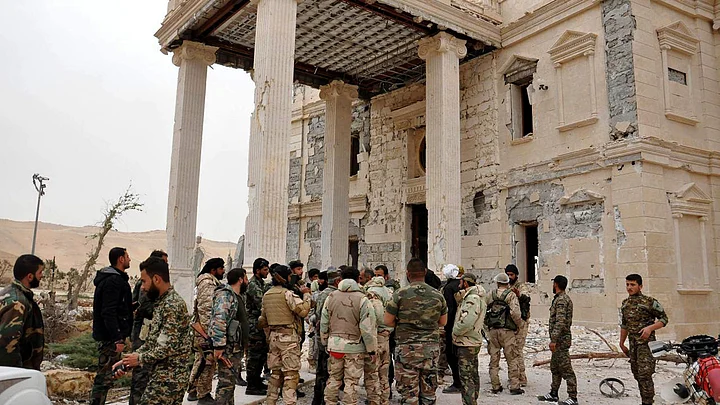The recapture of the ancient city of Palmyra by Syrian government forces scores an important victory over ISIS fighters who waged a 10-month reign of terror there and marks the first major defeat for the extremist group since an international agreement to battle terrorism in the fractured nation took effect last year.
The city known to Syrians as the “Bride of the Desert” is famous for its 2,000-year-old ruins that once drew tens of thousands of visitors each year before the ISIS group destroyed many of the monuments.
Damage
The extent of the destruction remained unclear after government troops took the town in central Syria on Sunday. Initial footage on Syrian state TV showed widespread rubble and shattered statues. But Palmyra’s grand colonnades appeared to be in relatively good condition.
ISIS Pressurised as Forces Take Control
The government forces were supported by Lebanese Hezbollah militiamen and Russian air power. ISIS now faces pressure on several fronts as Kurdish ground forces advance on its territory in Syria’s north and government forces, from Palmyra, have a new path to its de facto capital, Raqqa, and the contested eastern city of Deir el-Zour.
International airstrikes have pounded ISIS territory, killing two top leaders in recent weeks, according to the Pentagon. Those strikes have also inflicted dozens of civilian casualties.
In neighbouring Iraq, meanwhile, government forces backed by the US and Iran are preparing a ground offensive to retake the country’s second largest city, Mosul, from ISIS fighters.
‘Significant Achievement’
The fall of Palmyra comes a month after a partial cease-fire in Syria’s civil war came into force. The truce was sponsored by the US and Russia in part to allow the government and international community to focus on al-Qaida styled militants, among them ISIS.
In comments reported on state TV, Syrian President Bashar Assad described the Palmyra operation as a “significant achievement” offering “new evidence of the effectiveness of the strategy espoused by the Syrian army and its allies in the war against terrorism.”
Museum Damage
ISIS drove government forces from Palmyra in a matter of days last May and later demolished some of its best-known monuments, including two large temples dating back more than 1,800 years and a Roman triumphal archway.
State TV showed the rubble left over from the destruction of the Temple of Bel as well as the damaged archway, the supports of which were still standing. It said a statue of Zenobia, the third century queen who ruled an independent state from Palmyra and figures strongly in Syrian lore, was missing.
Artifacts inside the city’s museum also appeared heavily damaged on state TV. A sculpture of the Greek goddess Athena was decapitated, and the museum’s basement appeared to have been dynamited, the hall littered with broken statues.
Still, state media reported that a lion statue dating back to the second century, previously thought to have been destroyed by ISIS militants, was found in a damaged but recoverable condition.
Current Situation of Palmyra
Extremists beheaded the archaeological site’s 81-year-old director, Riad al-Asaad, in August after he reportedly refused to divulge where authorities had hidden some of the treasures before the group swept in. ISIS view the ruins as monuments to idolatry.
ISIS also demolished Palmyra’s infamous Tadmur prison in the town centre, where thousands of government opponents were reportedly tortured.
Syrian state TV hailed the government’s advance, and a local reporter spoke live from inside Palmyra, showing troops in the centre of the town, where some buildings had been reduced to rubble.
Rebuilding the Ruins
Culture Minister Issam Khalil described the recapture as a “victory for humanity and right over all projects of darkness.”
Maamoun Abdulkarim, director of the museums and antiquities department in Damascus, said Palmyra’s Great Colonnade had suffered only minor damage. Addressing ISIS he said:
We will rebuild what you have destroyed.
The Syrian opposition, which blames the government for the country’s devastating civil war and the rise of ISIS, rejected that narrative.
The government wants through this operation to win the favor of Western nations by fighting against terrorism, while obscuring its responsibility as providing the reasons for the spread of terror.Khaled Nasser, a member of the opposition coalition that has been negotiating with the government in Geneva.
The Britain-based Syrian Observatory for Human Rights, which monitors the conflict through local activists, confirmed that ISIS had lost the town. Observatory chief Rami Abdurrahman said three weeks of fighting killed more than 400 ISIS fighters, as well as 180 troops and allied militiamen.
Syria’s conflict began a little more than five years ago with mostly peaceful protests against the Assad family’s four-decade rule.
A fierce government crackdown and the rise of an insurgency plunged the country into a full-blown civil war that has killed more than 250,000 people.
